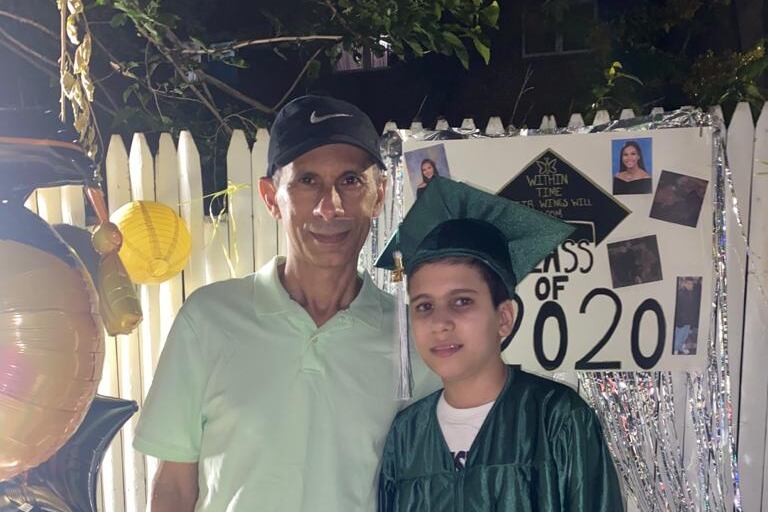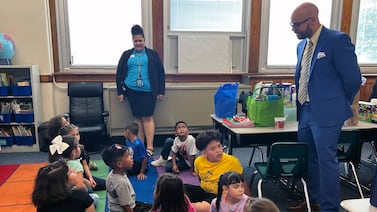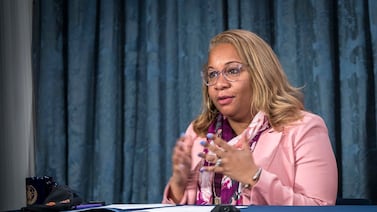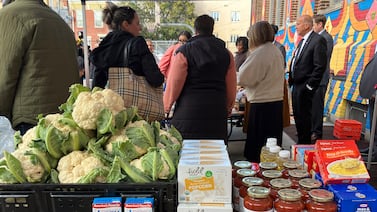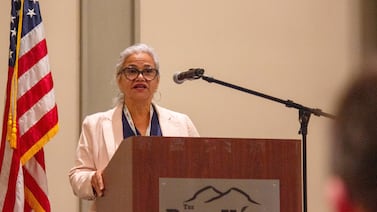George Badia was bracing this year for an enrollment drop at the school he leads in Elmhurst, Queens, exclusively serving new immigrants.
He knew that the pandemic had curtailed immigration, so he expected fewer students would come this year to Pan American International High School.
But he wasn’t expecting such a steep drop.
Pan American, which sits in New York City’s coronavirus epicenter, has enrolled 114 fewer students than projected for this year and is down 18% from last year. Others in Badia’s network of public high schools, which serve students who have been in the United States fewer than four years, have also seen significant drops. Together, the 15 schools averaged a 9% enrollment drop compared to last year, according to an internal network analysis. That is three times higher than the citywide average, according to a Chalkbeat analysis of preliminary data.
The enrollment drop is driven by numerous factors, from changes in immigration policy to disruptions in family life caused by the pandemic. Administrators are concerned the dip means some students may be missing out on education and services, but they also fear the financial ramifications of having lower enrollment could be dire. Schools could receive far less money next year, and they may also have to readjust their current budget and even give back a chunk of this year’s funds. But at many schools, that money may already be spent.
The education department recently informed Badia that he needed to return more than $660,000 because of the drop in his student register, he said. As of early this month, 362 students were enrolled at his school.
Those funding cuts could have a direct impact on students. Schools in the “Internationals” network are known for giving a lot of individual attention to English-learning students, who require more support and are more likely to drop out than their native English-speaking peers. The approach often pays off. An average 55% of students learning English at Internationals schools graduated on time in the 2018-2019 school year, 14 percentage points higher than English language learners citywide.
Smaller budgets next year, principals worry, could lead to less individual support and services for students at a time when they will likely need more attention due to the vast disruption of regular in-person learning.
“They’re gonna have to be tightening their belts significantly,” said Mark Cannizzarro, president of the Council of School Administrators, who has asked the education department to hold schools financially harmless next year. “We’re gonna have students come September who haven’t been in a school building for 18 months.”
Missing students
Enrollment has dropped by about 31,000 students across New York City public schools, with higher concentrations in affluent student bodies but more total students from schools with higher shares of low-income families, Chalkbeat found. Families have left the school system for myriad reasons: Some have opted for private or parochial schools, decided to formally homeschool their children, or moved to the suburbs and other states.
The Internationals Network schools face additional challenges.
Enrollment had been declining at the Internationals Network schools over the past four years due in part to the Trump administration’s curtailing of immigration, but this year’s drop was the most steep in recent memory, according to Joe Luft, the network’s executive director.
While high school enrollment citywide remained flat, all but one Internationals school saw declines this year compared to last, with the largest drop among incoming ninth graders, Luft said. He and some principals believe that’s largely driven by sweeping pandemic-related immigration restrictions, paired with other policy changes since 2016.
On top of that, a chunk of existing students did not return due to disruption caused by the pandemic, an internal network analysis found.
At Brooklyn’s International High School at Prospect Heights, one student lost a guardian to COVID-19, causing the family to rethink their living situation and move, according to principal Nedda de Castro. Others have left because adults have lost jobs or are reunifying with relatives in more affordable cities. Another student needs to work full-time in order to avoid eviction and is on the brink of dropping out, but the school is trying desperately to find ways to keep the student enrolled — providing lessons around work hours, she said.
Delvis Castillo, a 14-year-old who moved from the Dominican Republic to Queens last November, enrolled as a freshman at Pan American this year. But his family left last month, deciding they could no longer afford rent in New York City. Delvis’s father had been out of work since the start of the pandemic after losing his job at a local grocery store along with other newer employees. They went to a small town in Pennsylvania, where some cousins live.
Delvis is struggling in his new school, which is only offering virtual learning. He completes paper packets of work because he hasn’t received a device and doesn’t have internet connection at the apartment that he shares with his parents, his two older siblings, and their three children. His father is still searching for work.
“The process was difficult, but you need to adapt,” Delvis said in Spanish, of leaving New York City.
Many of the Internationals Network schools’ new students get on a school’s rolls between the summer and November every year and are new to the system, Luft said. At Badia’s school, for example, about 100 so-called “over-the-counter” students typically show up every year. This year, just 20 such students enrolled, he said.
“[The schools] have done all kinds of outreach, we’ve reached out on their behalf, they have reached out to [community based organizations],” Luft said. “Those referrals just aren’t coming because there just aren’t as many students coming into the city.”
A slowdown in immigration is likely a contributing factor, said Julia Gelatt, senior policy analyst at Migrant Policy Institute. In fiscal year 2020, 45% fewer visas and green cards were issued abroad compared to the prior year, while temporary visas dropped by 54%, she said. Many people aren’t coming because of the pandemic and travel restrictions.
Amy Hsin, an associate professor of sociology at Queens College who studies immigration and education, said it’s not just restrictive immigration policies affecting the declining demographics at the international schools.
“People lose jobs, and you know, any working-age person needs to now work to contribute to household finances,” Hsin said. That includes high school students.
Budget woes
As the Internationals network grapples with fewer students and the threat of losing money, they worry they may need to reduce the amount of individual support they provide. At Pan American, for instance, roughly 25% of Badia’s students have jobs and need help with course work outside of traditional school hours.
“Internationals schools are unique because they are able to reduce dropout rates tremendously,” Hsin said. “Once you’re dropping out at late ages, it’s much more difficult to come back. Right now there is a tremendous amount of pressure on immigrant families, low- income families, to put food on the table, to pay rent, to make ends meet, and I don’t think the economic effects of COVID are going to go away.”
Since Badia had anticipated an enrollment drop and had expected restrictions on school finances, he budgeted conservatively for this year.
He didn’t fill open teaching positions, helping free up other educators who do the critical work of identifying language levels for incoming students. He did not pay for tutoring services during winter and spring breaks, as he usually does, and he can’t provide extra individualized support for his students with interrupted formal education — some of the city’s highest need students.
But now, as Badia’s current 362-student enrollment will be used to calculate next school year’s budget, he is worried again. He thinks enrollment could rise next school year, as the vaccine is expected to lessen the pandemic’s grip on the city, and he anticipates more immigration-friendly policies under President-elect Joe Biden.
School budgets are based on enrollment projections that include not just the prior year’s figures, but also “a holistic historical analysis,” education department officials said. It is “premature” to make assumptions about budgets for next school year, officials added.
“We believe that classrooms should not bear the brunt of the fiscal challenges brought on by the pandemic and the vast majority of cuts have been made to DOE central to help shield our schools,” Katie O’Hanlon, a department spokesperson, said in a statement. “Our budget formula is driven by equity and need, and in these difficult times we’ve provided even more direct funding to schools to cover costs such as $80 million for additional staff, $50 [million] in cleaning supplies and PPE, and more.”
While Badia would get additional money if more students come next year, he wouldn’t receive it until halfway through the school year — which doesn’t help him with his main need, hiring teachers. That means class sizes could grow from about 22 students to 30, he predicts, making it difficult for a school that prides itself on providing individualized support.
“You don’t have the funding to also pay teachers to do extra support like tutoring or any additional academy to support the kids that [are] behind,” Badia said.
Yet, the need for such support is greater as remote learning has been challenging for many of the school’s students and some experts predict students will need to recover from learning loss.
De Castro, the Prospect Heights principal, also worries about larger class sizes, bigger advisory groups for students, and the inability to fill any vacancies “unless they’re absolutely necessary.” She saw a roughly 40-student drop at her school and owes the education department about $270,000. Since she can only set aside about $200,000 of those funds, she would start next school year with a deficit.
“It’s a constant sort of reorganizing, repurposing — this doesn’t go away,” De Castro said. “Either some people have to work more, you have to work differently, you prioritize.”

